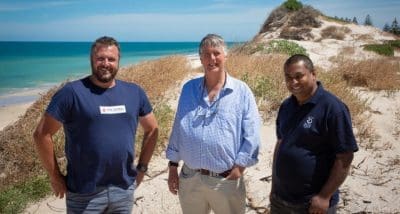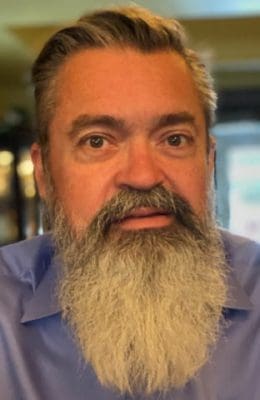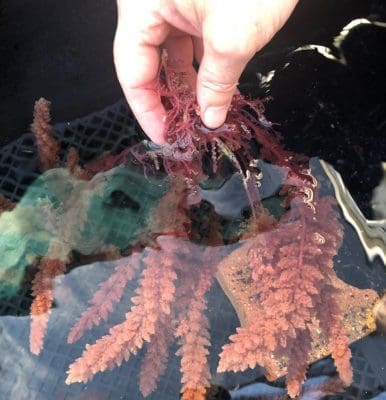Construction of the first processing plant to utilise red asparagopsis seaweed as a feed supplement to reduce the methane emissions of cattle will begin near Port Pirie, South Australia towards the end of this year.
The $90 million advanced processing multi-species facility will be built as the result of a partnership between Pirie Meats, CH4 Global, Organic Technology Holdings and Siemens Australia.

Adam Main, general manager of CH4, Steven Clarke and Sasi Nayar, both of whom work for the South Australian Research and Development Institute, where CH4 has tested and developed products. Supplied image.
Construction is scheduled to begin in the fourth quarter of this year and the processing facility will start initial operations within a year.
Once developed, the site will act as a “processing innovation hub” with the aim of driving further innovation in sustainable, carbon-neutral processing in the agriculture sector.
Cattle are a contributor to greenhouse gas emissions with each beast said to produce around 100kg of methane a year, on average.
CSIRO research found that the red seaweed asparagopsis mixed with regular cattle feed at a rate of 100 grams per head per day reduced methane production by 90pc.
CH4 Global has purchased a licence from patent owners CSIRO, Meat & Livestock Australia and James Cook University and gained regulatory approval for the material to be allowed to sell it in Australia.
The cold water asparagopsis species occurs naturally and grows well in waters around southern Australia and New Zealand.
In what’s claimed to be a world-first agreement, CH4 Global will initially provide Pirie Meats with enough asparagopsis supplement for up to 10,000 head of cattle.
The red seaweed will be cultivated by CH4 in South Australia where the company has signed a partnership agreement with the Narungga Nation Aboriginal Corporation (NNAC).

Steve Meller
“CH4 believes in circular and regenerative economic principles and is excited by our collaboration with Pirie Meats and partnership with NNAC,” CH4 Global chief executive and co-founder Steve Meller said.
“Working with the Narungga Aboriginal Nation to generate maximum sustainable benefit for its people – jobs, training, and a leadership role in climate mitigation is what CH4 is all about.”
CEO of Pirie Meats Reg Smyth said the expanded facility would establish a new standard for the future of sustainable livestock production and processing.
“Through strategic design of our operations and plant, our goal is for whole-of-animal product optimisation,” he said.
“Benefits will be realised from commitment to carbon-neutral operations, achieving our re-use targets and from a complete change in the way we process and what we produce.
“In addition to the more traditional processing operations, our facility will be capable of transitioning what was processing waste or very low-value product into high value human and medical-grade materials through a unique secondary processing line,” he said.
Expansion plans
Sustainable agriculture company CH4 plans to build its first two facilities in South Australia with further ‘eco-parks’ planned in the state, as well as in New Zealand.
Following this first site on the Yorke Peninsula, a second site has been identified near Port Lincoln on the Eyre Peninsula.
Each farm would be capable of producing about 400 tonnes of dry weight milled seaweed a year – enough to feed up to 20,000 cows.
“We’ve defined what we call an eco-park and the minimum size that makes sense is 20ha of aquaculture space in the water and two hectares on land containing a hatchery to grow the seedlings and a facility for processing,” Dr Meller said.
“We can build five of them together and farm 100ha, we can build one 20ha on its own and the idea is to have the first of those up and running and producing material by the end of next calendar year to validate the commercial objectives of financial viability.
“If they make money as we project they will, there will be opportunity to build lots of them because they each will make an inherent profit.
“They also do things like reduce ocean acidification, reduce excess nutrients in the water from agricultural runoff or from waste from an existing tuna or kingfish farm then, of course, the use of it reduces methane in cows and sheep.”
Each site is estimated to sustain 20-25 jobs including growing and harvesting the seaweed on the water and the staff in the production facility.
It takes about 45-60 days for a seaweed seedling from the hatchery to grow into a matured plant ready for harvest and processing.

Compounds in red asparagopsis seaweed have been found to reduce methane emissions from livestock by at least 80 percent
Dr Meller grew up in South Australia and completed a PhD in Neuroscience at the University of Adelaide. He moved to the United States more than 20 years ago and forged a career in disruptive innovations with consumer goods giant Proctor and Gamble.
He formed CH4 global in late 2018 after speaking at a World Energy Council meeting in NZ. The company has two wholly-owned subsidiaries – CH4 South Australia and CH4 Aotearoa.
It will focus on California, NZ and Australia as its first three markets with the 2.7 million dairy cows and those in beef feedlots in Australia targeted first.
He said CH4 had three goals: to act with urgency on climate change; work with indigenous peoples wherever we operate; and, put money in farmers’ pockets.
Dr Meller would not say exactly how much the milled seaweed supplement would cost but said it would lead to a 12-15 per cent reduction in the total food needed by cows and would also open up opportunities for niche dairy products.
He said asparagopsis worked by interfering with the last stage of methane production in a cow’s stomach where short chain fatty acids were converted to the gas before being belched out.
“So if the methane is blocked you’ve got 12-15 per cent more calories retained in the cow for the same amount of food.”
Dr Meller said consumers would be prepared to pay a premium for low-carbon milk or meat.
“That’s why people drive electric vehicles and use LED light bulbs – they are paying for the carbon that’s reduced,” he said.
“Brands beyond milk in products such as yoghurt, cheeses, chocolate and ice cream have had discussions with us about accessing low-carbon or zero impact milk. If a farmer makes 10pc more on the milk, it pays for the product and puts 25-50pc more money into their pocket.”
